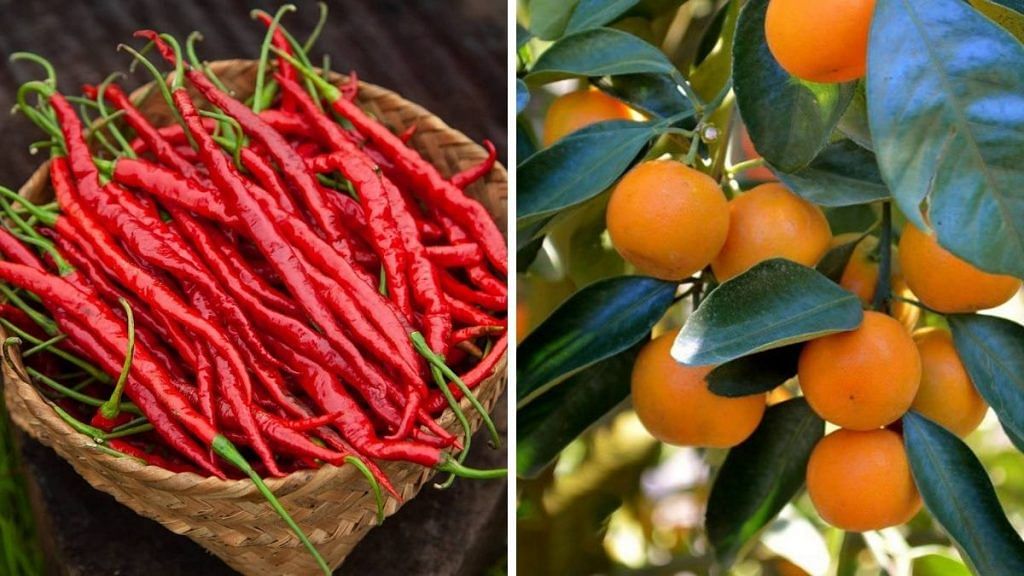New Delhi: Manipur’s Hathei chilli, known for its vibrant red colour and flavour, and the fruit Tamenglong orange have been granted the Geographical Indication (GI) tag. A GI is a sign used on products that have a specific geographical origin.
Hathei, a chilly variety grown in the state’s Ukhrul district, is believed to be a ‘God’s gift’ by the locals of Sirarakhong village where it is predominantly grown. Such is its popularity that a festival is celebrated every year to promote the chilli variety that has now become a lifeline for Sirarakhong residents.
What a great start to the day for Manipur!
I’m really happy to share that 2 (two) products of Manipur viz Hathei Chilly & Tamenglong orange have been granted GI Tag. This is a historic milestone in the history of Manipur which will increase the income of the farmers immensely. pic.twitter.com/nFeXSE5KBQ
— N.Biren Singh (@NBirenSingh) September 17, 2021
It is said that the chilli variety was first discovered by the elders of Sirarakhong while hunting in the forest. The village also has a folk song dedicated to Hathei in which the chilli is compared to a prized shawl of the Tangkhul Naga tribe called ‘Khuilang’.
The state’s Tamenglong district, meanwhile, produces a unique variety of oranges belonging to the mandarin group. Tamenglong is also known as the state’s ‘orange bowl’ for the fruit, which has also been rated as one of the best in the world.
Also read: This Nagaland village council has decided to not pay ‘taxes’ till underground groups unite
8-year-old from Nagaland develops app to feed the needy
Zaiyigum Zeliang has become Nagaland’s youngest certified app developer. The eight-year-old, a student at Dimapur’s Hollotoli School, took to learning coding only last year when schools were shut to curb the spread of Covid-19.
Last month, Zaiyigum and his father Kangzang Zeliang teamed up for the Start-Up Nagaland Hackathon 2021 and secured the second position for an app called ‘Feed the Needy’.
Talking to EastMojo, Kangzang explained that it was a “charity app”, through which people can “donate extra food — cooked or uncooked — to the needy”.
“I was involved in the competition because the minimum requirement for the team was two people. I was just a cover up,” Kangzang added.
The boy is developing another app called PTI (parents teachers interaction) to ease communication between parents and teachers on children’s performances in school.
Meghalaya Assembly begins session with national anthem using Khasi, Garo instruments
The first day of the Meghalaya Assembly session last week began with the national anthem being played using traditional Khasi and Garo instruments. The man behind this first-of-its-kind initiative was Meghalaya Assembly speaker Metbah Lyngdoh.
Lyngdoh had roped in musician Lamphang Syiemlieh for the project “to give a different touch and feel” to the national anthem, reported The Shillong Times.
“I sought the help of a friend in Parliament to find out the rules and regulations about the national anthem. I wanted to make absolutely sure before accepting the project since I did not want to run into any kind of problem,” Syiemlieh has been quoted as saying.
He added, “It was the biggest compliment to hear from Power Minister James PK Sangma that he got goosebumps right from the start and till the end.”
The traditional instruments used for the national anthem include a large kettledrum called ‘bom’ played by Banshai Mukhim, ‘duitara’ played by Haniel Reuel Kharlukhi, percussion instrument ‘ksing’ played by Franky Mylliemngap and a bamboo stump with strings called ‘chigring’ played by Phrangsngi Wahlang.
Tripura horticulture department develops ‘yellow’ watermelons, to hit markets soon
The Department of Horticulture and Land Conservation in Tripura has successfully experimented and grown two varieties of yellow watermelons. Researchers have hybridised the fruit, originally grown in the African continent, to make it suitable for cultivation in the state.
“Two types of watermelons have been cultivated experimentally. These are Yellow Box and Yellow Gold, which is very good. The maximum requirement of this variety is up to about 3 kg. Red watermelon is a bit spongy to eat but yellow watermelon is crispy,” Rajiv Ghosh, involved with the project, told EastMojo.
Ghosh also explained how the red colour in watermelons or tomatoes comes from an antioxidant called lycopene. “The reason the inside of the watermelon turns yellow is due to the presence of beta-carotene and xanthophyll. Yellow watermelon is very tasty and delicious to eat,” he has been quoted as saying.
The seeds of yellow watermelons are sown around December and cultivated during summer. This unique variety is likely to hit the markets soon.
Also read: Arunachal farmer turns teacher to save his tribe’s endangered Tangsa language
